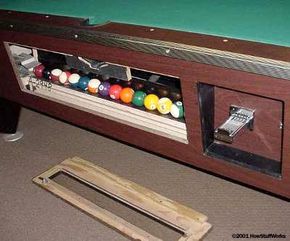If you have ever played one of those coin-operated pool tables in a place like a restaurant or an arcade, then you know that the obvious question is, "how the heck does this thing return the cue ball to me???" If you look inside the table, there is a system of chutes that connect to the six pockets on the table. Each chute sends a pocketed ball from the pocket to a collection chamber, where the numbered balls are lined up single file. These numbered balls remain locked in the chamber, which you can see behind a piece of Plexiglas, until someone wants to play a game and inserts some coins. Of course the cue ball can't get stuck in this chamber -- If a player accidentally pockets the cue ball (a scratch), the cue ball needs to come back out.
Table manufacturers needed a way to allow the cue ball to be returned to play, while keeping the pocketed numbered balls locked in the storage compartment. Many solutions have been proposed to solve this problem, including:
Advertisement
- Light sensors that sense the light reflected from the cue ball
- A metallic core ball that would trigger a separating mechanism when it passed through an electromagnetic field
- A balance mechanism that would separate a heavier cue ball from lighter numbered balls
And so on. For the most part, though, coin-operated tables use two types of cue balls that can be easily separated:
- An oversized ball that is separated by a radius gauging device.
- A magnetic cue ball that triggers a magnetic detector.
The oversized ball is approximately 2 3/8 inches (6 cm) in diameter, which is about one-eighth (2 mm) of an inch larger than a normal ball. This slight difference in size allows the cue ball to be separated before it gets to the storage compartment. The smaller numbered balls are able to pass through a gauging mechanism, while the larger cue ball is directed through a second chute, where it falls out into an opening on the side of the table.
For players who dislike using the slightly larger cue ball, there are also coin-operated machines that can use a magnetic ball, in which a magnet is built into the core of the cue ball. Magnetic cue balls that go into a pocket are separated from numbered balls by a magnetic detector. As the magnetic ball passes this detector, the magnet triggers a deflecting device that separates the cue ball and, again, sends it into the opening on the side of the table.
Both the oversized and magnetic cue balls can be used interchangeably on most of today's coin-operated tables, but each has its shortcomings. If you are a beginning pool player the larger ball might not affect your play, but it can disrupt the play of some advanced players who are used to playing with the normal 2 1/4-inch cue ball. Likewise, some players will notice a difference in the properties of a magnetic ball, which sometimes lacks a true roll. Also, because the magnetic ball has the magnetic material inserted into it, it has a greater tendency to shatter if dropped on a hard surface.
Here are some interesting links:
- Pool Tables and Billiard Games
- Building a Pool Table
- Dynamo Pool Tables
- Pool Table Plans
Advertisement
